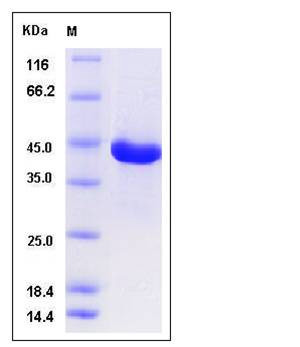Human SerpinB3 / SCCA-1 Protein (His Tag)
HsT1196,SCC,SCCA-1,SCCA-PD,SCCA1,T4-A
- 100ug (NPP2492) Please inquiry
| Catalog Number | P13218-H07B |
|---|---|
| Organism Species | Human |
| Host | Baculovirus-Insect Cells |
| Synonyms | HsT1196,SCC,SCCA-1,SCCA-PD,SCCA1,T4-A |
| Molecular Weight | The recombinant human SERPINB3 consists of 408 amino acids and predicts a molecular mass of 46.7 kDa. It migrates as an approximately 43 KDa band in SDS-PAGE under reducing conditions. |
| predicted N | Met |
| SDS-PAGE |  |
| Purity | > 97 % as determined by SDS-PAGE |
| Protein Construction | A DNA sequence encoding the human SERPINB3 (AAB20405.1) (Asn 2-Pro 390) was expressed, with a polyhistidine tag at the N-terminus. |
| Bio-activity | Measured by its ability to inhibit active Cathepsin L cleavage of a fluorogenice peptide substrate Z-LR-AMC, R&D Systems, Catalog # ES008. The IC50 is < 5 nM. |
| Research Area | Signaling |Signal Transduction |Growth Factor & Receptor |Fibroblast Growth Factor (FGF) & Receptor |Fibroblast Growth Factor (FGF) |
| Formulation | Lyophilized from sterile 20mM Tris, 500mM NaCl, pH 7.4, 20% gly, 3mM DTT 1. Normally 5 % - 8 % trehalose and mannitol are added as protectants before lyophilization. Specific concentrations are included in the hardcopy of COA. |
| Background | SERPINB3, also known as SCCA-1, belongs to the serpin family. Serpins are a group of proteins with similar structures that were first identified as a set of proteins able to inhibit proteases. The acronym serpin was originally coined because many serpins inhibit chymotrypsin-like serine proteases. SERPINB3 is expressed in some hepatocellular carcinoma (at protein level). Its expression is closely related to cellular differentiation in both normal and malignant squamous cells. It seems to also be secreted in plasma by cancerous cells but at a low level. SERPINB3 significantly attenuates apoptosis by contrasting cytochrome c release from the mitochondria and by antichemotactic effect for NK cells. It may act as a protease inhibitor to modulate the host immune response against tumor cells and may be involved in the malignant behavior of squamous cell carcinoma cells. |
| Reference |
